WATERVILLE – When the scanner radio in the front of the white RAV4 squawked with static, Tim Pieh leaned in to decipher what was being said.

Dr. Tim Pieh talks about a handheld ultrasound device Sept. 7 at the Kennebec County Emergency Management Agency in Augusta. Joe Phelan/Kennebec Journal
Pieh, an emergency medicine physician at MaineGeneral Medical Center in Augusta, was heading north on Interstate 95 to stop by the fire station in Clinton, one of many stops he made on his rounds in mid-January.
It wasn’t a firm appointment, so Pieh was prepared to switch gears. As one of three doctors staffing Kennebec County’s new MD3 program, it was his job on that day to respond to medical emergencies if needed, to provide physician-level care in the field.
With funding available to take the program — the first of its kind in northern New England — through September this year, Pieh and his colleagues are working hard to make the case that they can meet the need for critical care in the field when having that available could save a life. The program comes amid a paramedic shortage that has reached into the communities across the region and some rescue agencies are struggling to hire paramedics.
The next couple of weeks could be crucial for MD3, because that’s when Kennebec County officials will approve the budget for the upcoming fiscal year that could extend the program beyond September.
In the last month or two, Pieh, Kelly Meehan-Coussee and Jonnathan Busko, all emergency medicine physicians and part of the MD3 program, have been visiting fire and rescue services, connecting with first responders and explaining the services they offer.
The program’s name is a nod to its staffing with medical doctors and Kennebec County’s EMS region, which is Region 3 — hence, MD3.
The conversations are low-key and focused on making connections over a cup of coffee or standing in a bay in the fire station, showing the equipment carried in MD3’s RAV4.
They have also been responding to calls, including a pregnancy emergency, a diabetic coma, a vehicle crash, six seizures and a cardiac arrest in which a person was revived.

Kennebec County emergency planner Theo Marshall, left, Melissa Adams, a licensing agent from Maine Department of Public Safety, and Dr. Tim Pieh look over medical gear that will be used on the county’s vehicle on Sept. 7 at the Kennebec County Emergency Management Agency in Augusta. Joe Phelan/Kennebec Journal
“One of the things we have discussed is that having a physician respond could limit some of the calls we’re doing,” Meehan-Coussee said. “So let me examine you in the field and decide you don’t need to go to the emergency department right now. Maybe you need to follow up with your primary care doctor. Maybe I need to write you a prescription for your cellulitis. Maybe I need to wash out and repair your wound. Maybe I need to remove your fish hook.”
All of that can keep people out of hospital emergency departments, which are busy and often have lengthy wait times to be seen.
At the same time, the doctors of MD3 also provide an extra pair of hands to help out emergency responders.

Dr. Kelly Coussee-Meehan, one of the emergency medicine physicians who has signed on to the MD3 program, watches while Gardiner Fire Lt. Justin Lodolce (right) uses a video laryngoscope on a dummy. Jessica Lowell/Kennebec Journal
“So many of our agencies have positions that are open,” Meehan-Coussee said.
While the licensure levels for emergency medical service have remained steady, she said many of the providers who routinely may have worked three different jobs — as a full-time paramedic, a small department chief and on a per-diem basis with other departments — have scaled back and have taken second jobs in construction or teaching.
“Our providers have gotten burned out, and they never really got the break during the pandemic that many other individuals got, to stay at home and clean out their closets,” she said.
IDEA IN THE MAKING
Pieh has been thinking about this for years.
What if physician-level help were available when immediate treatment could make the difference between life and death? What if people who didn’t need to go to the hospital could be sent home, freeing up time and resources for both emergency services and the ER?

Clinton Firefighter/Advanced EMT Dakota Bartlett, left, Clinton Assistant Fire Chief Randy Caswell, center, and Dr. Tim Pieh chat next to the MD3 vehicle Jan. 18 at the Clinton Fire and Rescue station. Joe Phelan/Kennebec Journal
In one form or another, that impulse has been with Pieh for decades, but it didn’t crystallize until one day in college, when he received a copy of JEMS, the Journal of Emergency Medical Services. On the cover was a county-level EMS medical director from Texas, a physician who responded to medical emergencies in a fly car.

While driving from Waterville to Augusta at the end of his Jan. 18 shift, Dr. Tim Pieh stops by as the Augusta Fire Department is putting out a chimney fire on Leighton Road in Augusta. Joe Phelan/Kennebec Journal
“I thought: What the? I had no idea that was even possible,” Pieh said.
Pieh was on track to be a history teacher and paramedic, thanks to the EMT training he took at the close of his senior year of high school in Massachusetts. When his family moved to Arrowsic not long after, he volunteered in Georgetown, with its basic life-support ambulance. And when he went to college at Duke University in North Carolina, he and fellow students launched an on-campus first responder agency.
During the summers, he was doing search and rescue and wilderness medicine while working at the North Carolina Outward Bound school.
And he’s been doing it. Pieh, who is a medical director for the Kennebec Valley region and the Augusta Fire Department, is also a member of the Belgrade and Rome fire departments.
Services like MD3 are in operation elsewhere in the world and in this country. Across Europe, Meehan-Coussee said, emergency medical response brings both a paramedic and a physician. And in both large U.S. cities and rural communities, the practice has also been adopted.
Meehan-Coussee, who also started out as a paramedic, said evidence from other states shows that having an emergency physician respond on rescue calls bolsters the care being given and adds another person to the mix who can do additional procedures, provide differential diagnoses and administer medications.
At the same time, those physicians provide education to the paramedics and EMTs and can review how incidents were handled.
“There’s a lot that comes with being an EMS physician, and we don’t have many in the state,” she said. “But those of us who are practicing in the state have long wanted to bring something like this to the state of Maine.”
MAKING CONNECTIONS
In Clinton, earlier this month, Pieh spent a little more than hour with Randy Caswell, the assistant chief, and Dakota Bartlett, one of the firefighters and an advanced EMT, swapping stories and trading tips on filing paperwork.
Lifting the back gate, Pieh pulled out one of the bags to show some of MD3’s equipment, including a ventilator.

Dr. Tim Pieh drives the MD3 response vehicle on Jan. 18 in Clinton. Joe Phelan/Kennebec Journal
“That’s an asset; it’s pretty unique, right?” he said. “That’s LifeFlight or Delta (Ambulance).”
“You can do that from the scene?” Caswell said. “Because Delta can’t.”
“If we needed to, if we were at that level of acuity on a call,” Pieh said.
In a cardiac arrest, once he gets a pulse, he can hook up MD3’s ventilator, which is both easier and safer for the patient, and it leaves him free to focus on the next thing.
MD3 also would provide access to blood in the field, which paramedics can’t use, and it can provide what Pieh calls “fancy doc meds.”
Part of Pieh’s mission is to explain where MD3 can be plugged in, in addition to other critical services that are available, like LifeFlight of Maine, the state’s air ambulance service that will dispatch a helicopter to trauma scenes in which a patient is in dire need of high-level medical care at a hospital. With its equipment and the skill level of its staff, Pieh said it might be on another call, or weather might have grounded it.

While driving from Waterville to Augusta at the end of shift, Dr. Tim Pieh, bottom left in yellow, stops by as the Augusta Fire Department is putting out a chimney fire Thursday on Leighton Road in Augusta. Joe Phelan/Kennebec Journal
He recalled an incident involving a severe motor vehicle crash in the Kennebec County town of China. “LifeFlight was requested. It couldn’t come because it was a bad storm. Not their fault, it’s just the weather. And we were called,” Pieh said.
The goal is not to get in the way or take over, he said, or worry about a doctor looking over their shoulders.
“That’s not the point,” he said. “It’s if you need help, something beyond what you have. Otherwise I’ll hold an umbrella and keep you dry.”
“You guys are the first ones in the state doing this?” Bartlett said.
“First in northern New England,” Pieh said. “It’s pretty crazy.”
A similar program is being launched in Portland, where a fellowship is allowing a doctor who has just completed emergency medical training into the field alongside the Portland Fire Department.
MANAGING THE FUTURE
The mid-December launch of MD3 was about two years in the making.

Dr. Tim Pieh chats with first responders during a Jan. 18 meeting at the Clinton Fire and Rescue station. Joe Phelan/Kennebec Journal
As a member of the Belgrade and Rome fire departments, Pieh had been responding to medical situations in those two towns for years. The path forward to expanding that kind of response countywide wasn’t always clear.
Kennebec County’s $23.7 million American Rescue Plan Act allocation offered a unique opportunity. Working with the county’s Emergency Management Agency, Pieh made a request for funding to Kennebec County commissioners in 2022. They agreed to allocate $345,000 in federal funds to run a pilot program.
Since then, Pieh and others have been working through putting the program together, securing a vehicle, outfitting it with equipment and supplies, getting insurance, figuring out how to dispatch MD3, analyzing call volumes and working out a dependable schedule.
“Our goal is Monday through Friday, 8 a.m. to 8 p.m.,” he said last fall, as details were falling into place. “We needed to pick something rigid so EMS providers in the field have a sense of when the resource is available.”
Pieh said he’s continuing to recruit physicians to fill out all the shifts.
While Pieh and his colleagues have been working to prove the concept can work and be a service to Kennebec County, the budget deadline looms. The federal ARPA funding that has paid for the vehicle is expected to be spent by September, just 10 months after the pilot program launched.

Dr. Tim Pieh, left, and Clinton Firefighter/Advanced EMT Dakota Bartlett chat alongside the MD3 vehicle Jan. 18 at the Clinton Fire and Rescue station. Joe Phelan/Kennebec Journal
County officials are now preparing their proposed budget to send to the county’s budget committee in early February, ahead of three scheduled budget committee meetings that month.
Scott Ferguson, Kennebec County administrator, said a funding request for the program will be included in the budget. The EMA budget includes a request for about $350,000 to continue the program beyond September.
The committee is expected to approve the spending plan March 6, following public hearings in Waterville and Augusta. The county commissioners are expected to vote to adopt it March 19.
Throughout the process of launching MD3, the commissioners have been updated on the progress.

Dr. Tim Pieh, left, listens Jan. 18 as Chip Getchell, a critical care paramedic and Delta Ambulance’s clinical quality manager, tells him about this new portable ventilator that will be used for training at the Delta Ambulance office in Waterville. Joe Phelan/Kennebec Journal
“In the beginning, I think I was a little skeptical,” said Patsy Crockett, chairwoman of the county commissioners.
But during Pieh’s update to commissioners earlier this month, Crockett said she got a better understanding of the program and the educational possibilities it opens up.
“I hope when people see more about it, they’ll want to know more about it,” Crockett said. “Anything new has got to be funded to get started, and hopefully people will want to participate more.”
And she hopes the county will be able to find some grant funding to help pay for it.
In Clinton, Caswell said he didn’t think there would be any pushback if this service were to be added to the county tax assessment.
“This is somebody’s life,” he said, “and we can’t put a price on somebody’s life,” he said.
Send questions/comments to the editors.


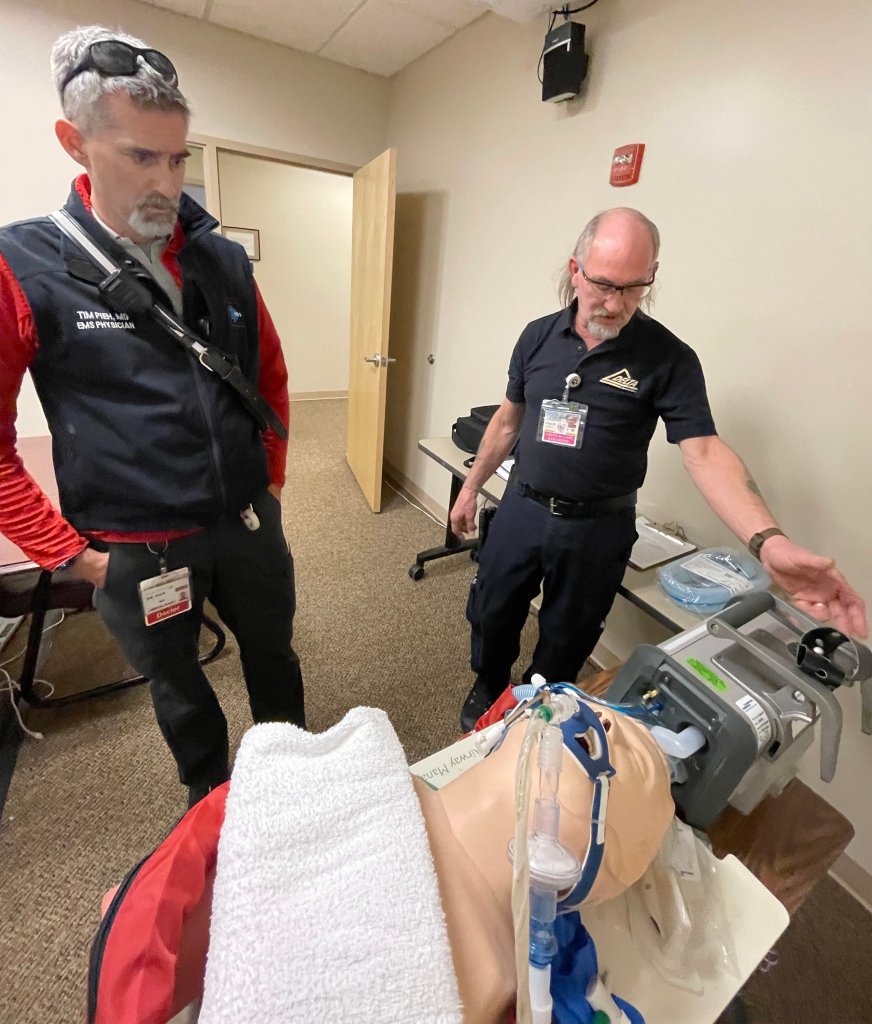


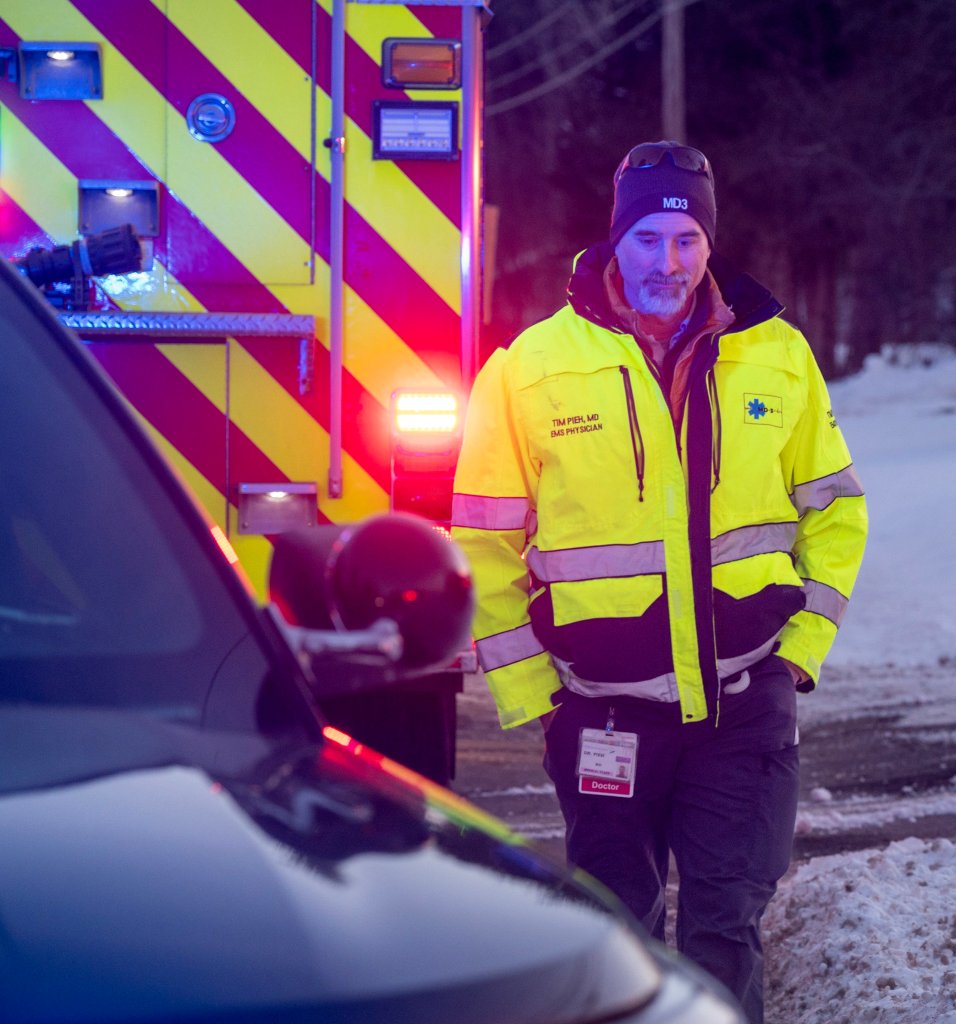







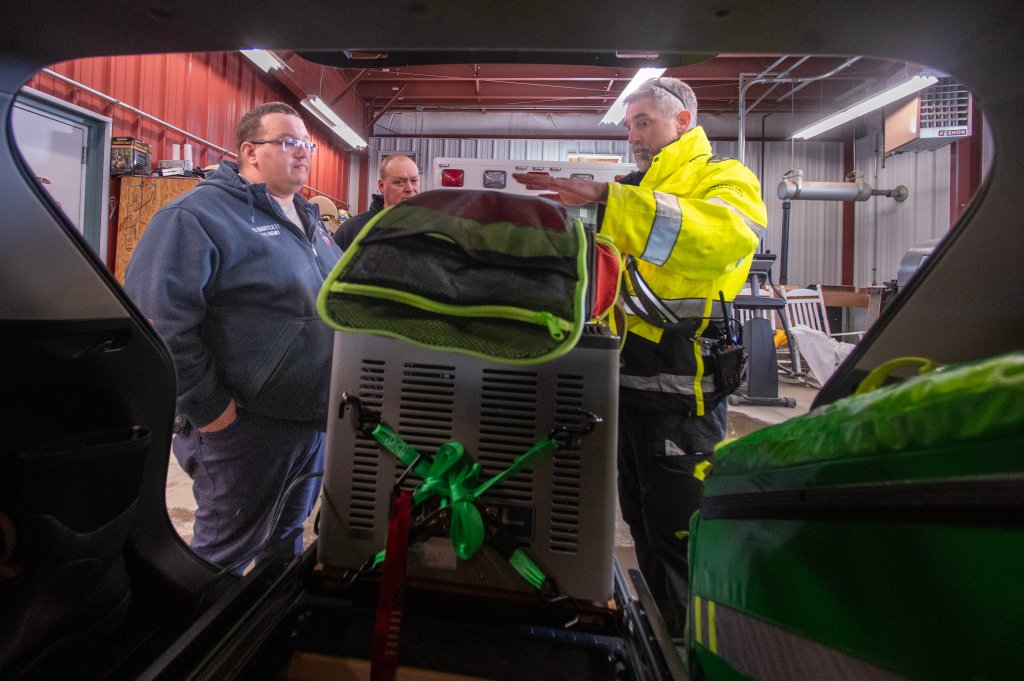

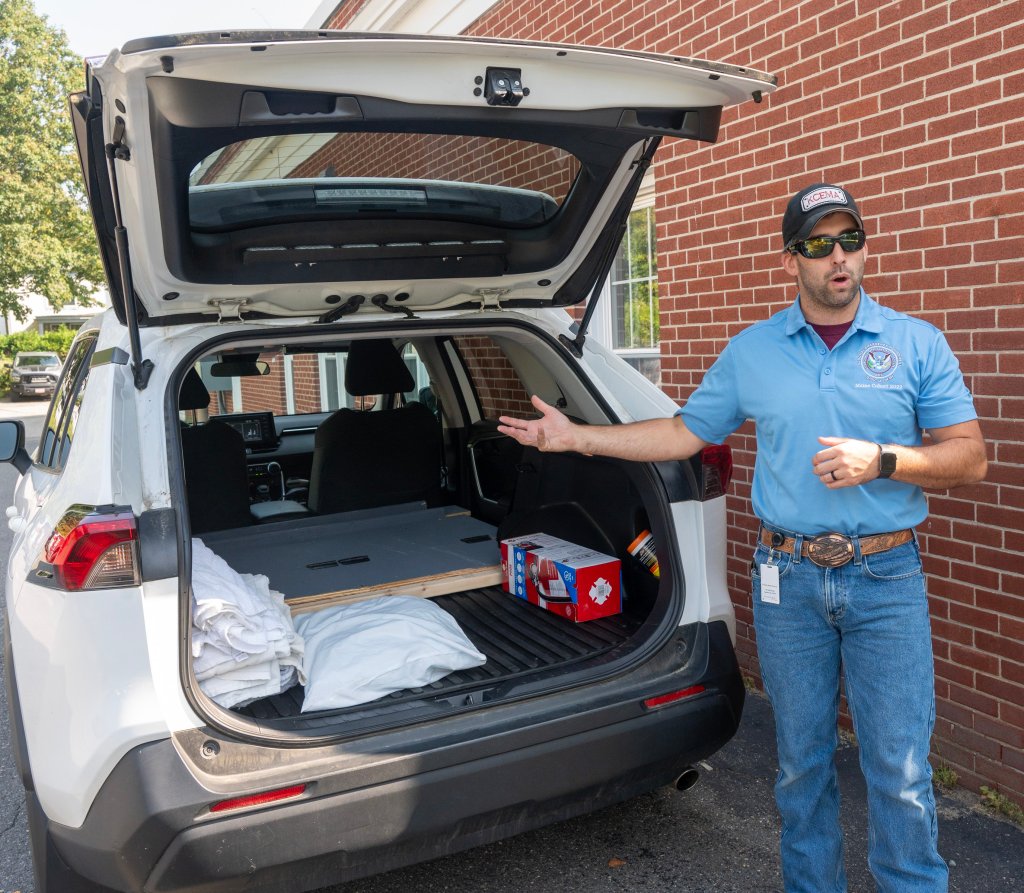





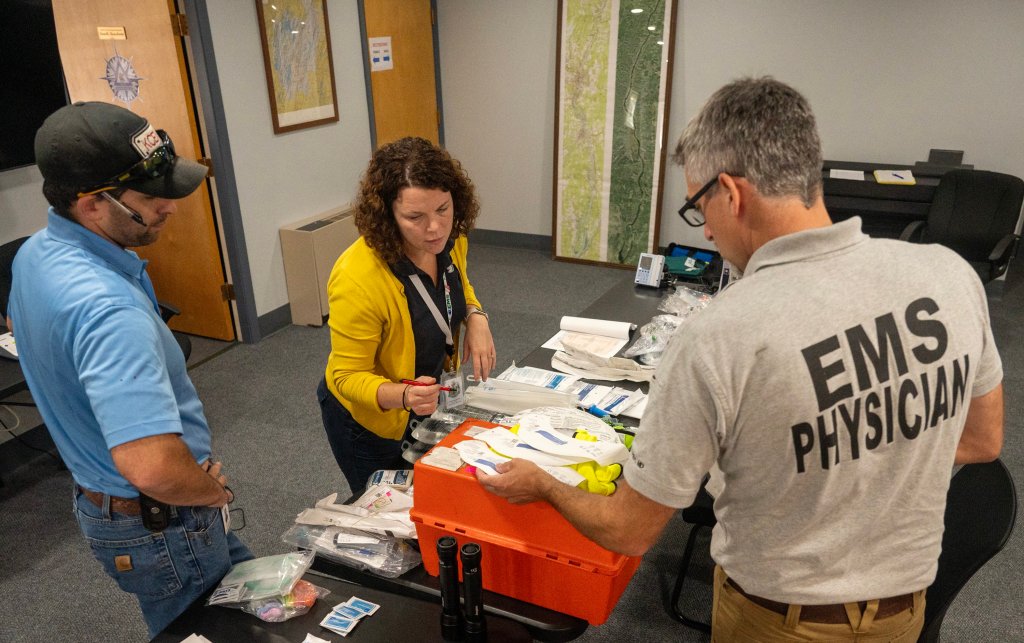








Comments are no longer available on this story